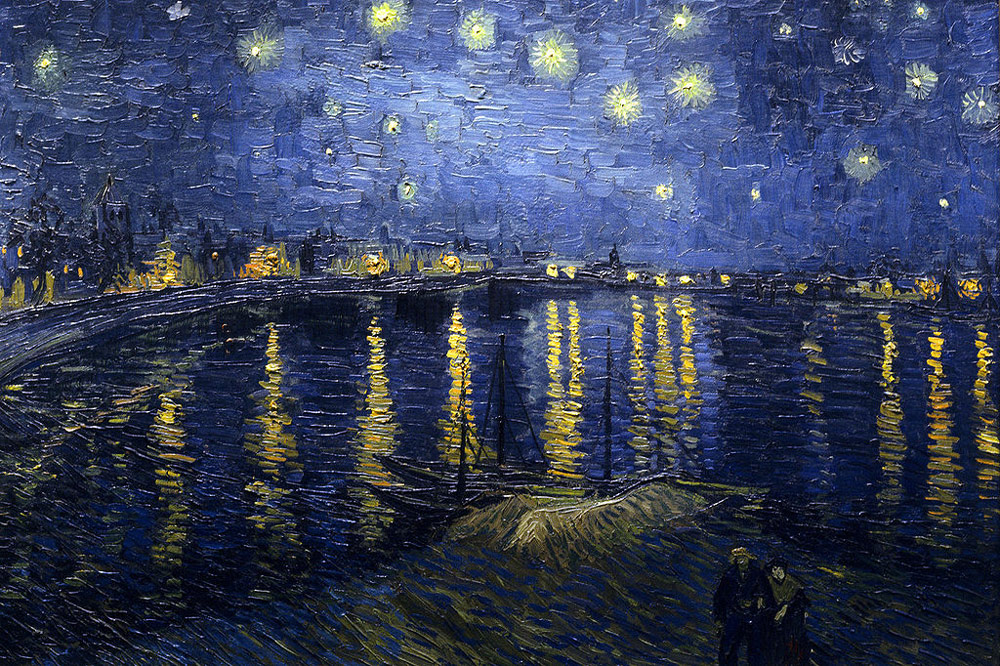| Starry Night Over the Rhone | |
|---|---|
 |
|
| Artist | Vincent van Gogh |
| Year | 1888 |
| Medium | Oil on canvas |
| Location | Musée d’Orsay, Paris |
| Dimensions | 28.5 in × 36.2 in |
| 72.5 cm × 92 cm | |
| Vincent van Gogh Famous Paintings | |
| The Starry Night, 1889 | |
| Sunflowers, 1888 | |
| Starry Night Over the Rhone, 1888 | |
| Irises, 1889 | |
| The Potato Eaters, 1885 | |
| Yellow House, 1888 | |
| Café Terrace at Night, 1888 | |
| The Red Vineyard, 1888 | |
| Outskirts of Paris, 1887 |
Starry Night Over the Rhone, a popular painting that was that was drawn in September 1888 by an expressionist artist, Vincent van Gogh. Van Gogh’s art is amongst the finest, highly prized and sought-after today.
The painting is set on the banks of Rhone River that passes near Place Lamartine, a place where the artist had rented an apartment. Vincent had sent a sketch of the painting to a friend named Eugene Boch on 2nd September 1888. This particular Arles at night painting is usually classified with other related paintings by Vincent van Gogh that constitutes a Starry Night Works montage. The painting was firstly exhibited in Paris in 1889 at an annual exhibition.
The Painting
Starry Night Over the Rhone is the painting that is said to have given Vincent the perspective that he employed in his later Starry Night paintings. It is differentiated from other Vincent’s Starry Night paintings because it contains human beings. The painting shows a starry night over a section of Rhone River at night. It captures the gas lighting in Arles at night and an illuminated sky. The gas lighting reflections are clearly captured against the background of glimmering blue waters of Rhone River. On the foreground there are two individuals (seemingly a couple) strolling along the river banks. The stars in the night are surrounded by an orb of their natural light. Additionally, the painting captures distant structures that are dimly lit by the artificial light.
Significant Features
Trying to understand the significance of this painting may help in highlighting why it is still popular today. Notably, it was produced at a time when Vincent felt that he needed religious guidance. The painting is usually classified alongside a collection of Vincent’s Starry Night paintings. However, it stands out from the rest because it has human forms and is considered to be the cornerstone painting that gave Vincent his approach to other Starry Night paintings. Some of the important features that are bound by the painting include: evened visual weight, presence of humans, and present forms.
Evened Visual Weight
A closer look at the Starry Night Over the Rhone painting reveals that Vincent gave equal visual weight to all the things that he painted. He did not exploit variations of elements like color intensity, paint texture, and dynamic movement. In this painting there is no visual distinction between the earth and the sky. For instance, the light from the stars is reflected together with that of the city lights in the Rhone River.
Presence of Humans
Inclusion of human forms in this painting has a lot of significance because they add a touch of natural quality. They also enable the painting to have a natural environmental setting that is pleasurable to look at.
Present Forms
Vincent drew the original painting on a canvas material. However, hand-painted reproductions by various artists today are widely available. Equally, Starry Night Over the Rhone painting has been reproduced in various computerized printouts and sold all over the world to interested art collectors.